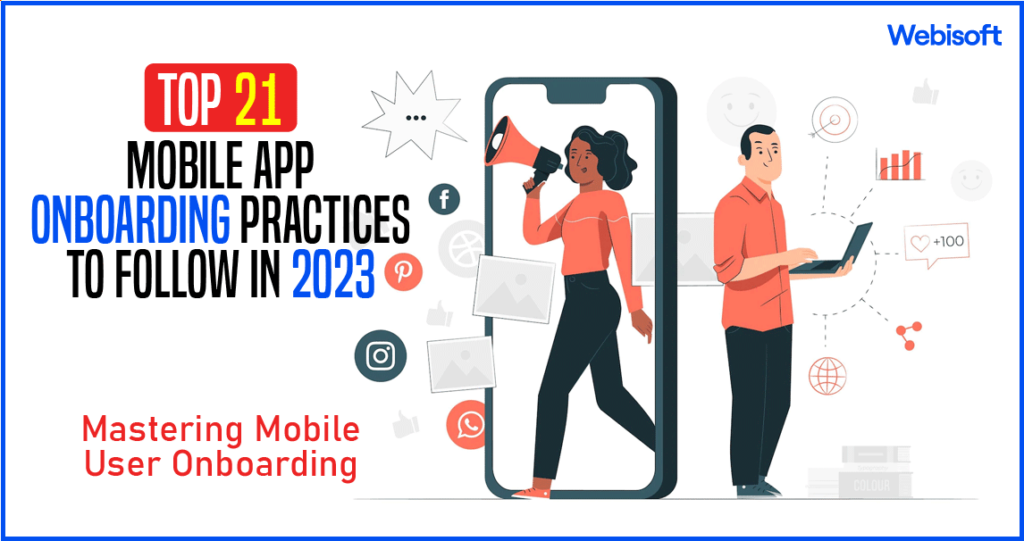Unlocking the potential of a mobile app and capturing the hearts of users is a delicate dance, choreographed with precision. In the ever-evolving landscape of technology, where attention spans waver and competition surges, the art of onboarding has become a crucial element in ensuring a seamless user experience. As we step into the promising year of 2024, the realm of mobile app onboarding continues to witness transformative trends and groundbreaking practices that hold the key to success.
In this article, we unveil the top 21 mobile app onboarding practices that will propel your app toward greater heights, creating a lasting impression and fostering user loyalty. From immersive storytelling to intuitive gestures, from personalized interactions to gamified experiences, prepare to embark on a journey where innovation meets user-centricity.
Are you ready to explore the cutting-edge techniques that will captivate users and elevate your app to the forefront of the digital revolution? Let’s dive in and discover the top 21 mobile app onboarding practices to follow in 2024 to conquer the realm of mobile apps.
Contents
- 1 What Exactly is Mobile App Onboarding?
- 2 Types of Mobile App Onboarding
- 3 Advantages of Using Mobile App Onboarding
- 4 21 Must-follow Mobile App Onboarding Practices
- 4.1 1. Clear and Concise Messaging
- 4.2 2. Visual Guidance
- 4.3 3. Progressive Onboarding
- 4.4 4. Interactive Tutorials
- 4.5 5. Personalized Recommendations
- 4.6 6. Gamified Elements
- 4.7 7. Onboarding Videos
- 4.8 8. Onboarding Checklists
- 4.9 9. User Onboarding Surveys
- 4.10 10. Onboarding Notifications
- 4.11 11. Social Sign-In
- 4.12 12. Contextual Help
- 4.13 13. Onboarding Progress Indicators
- 4.14 14. Offline Onboarding
- 4.15 15. Minimal Input Fields
- 4.16 16. App Permissions Explanation
- 4.17 17. Onboarding A/B Testing
- 4.18 18. Onboarding Analytics
- 4.19 19. Onboarding Feedback Channels
- 4.20 20. Onboarding Localization
- 4.21 21. Continuous Improvement
- 5 5 Real-life Instances of Correct Mobile App Onboarding
- 6 Frequently Asked Questions
- 7 Final Thoughts
What Exactly is Mobile App Onboarding?
Imagine you’ve just downloaded a new mobile app that promises to make your life easier or more fun. You open it excitedly, but suddenly feel overwhelmed and confused. Where do you start? What does each button do? That’s where mobile app onboarding comes in.
Mobile app onboarding is like a friendly guide that welcomes you and shows you around a new app. It helps you understand how to use the app and its features, so you can get the most out of it from the very beginning.
Think of it as a virtual tour. Onboarding typically begins with a welcome screen that introduces you to the app’s purpose and highlights its key benefits. It may include a brief tutorial or a series of screens that explain how to navigate through the app.
The ultimate goals of mobile app onboarding can be summarized in three words:
- Engage: Mobile app onboarding aims to capture users’ attention and create an enticing experience right from the start.
- Educate: Onboarding guides users through the app, teaching them how to navigate, understand its purpose, and utilize its features effectively.
- Retain: The goal is to demonstrate the app’s value and benefits, encouraging users to continue using it and fostering long-term engagement.
Types of Mobile App Onboarding
There are different types of onboarding techniques used to introduce users to a mobile app. Let’s explore some of the common ones:
1. Interactive Walkthrough: This type of onboarding takes users on a step-by-step tour of the app’s key features. It often includes interactive elements like swiping or tapping to guide users through different screens and actions.
2. Progressive Onboarding: With progressive onboarding, users are introduced to the app’s features gradually over time. It starts with the basics and progressively reveals more advanced features as users become more familiar with the app.
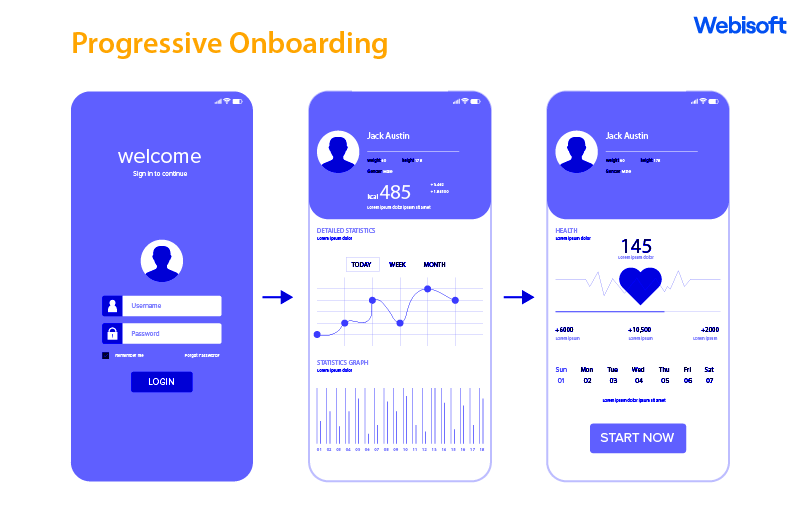
3. Video Tutorials: Video tutorials provide a visual demonstration of how to use the app. They walk users through various tasks and explain different features, making it easier to understand and follow along.
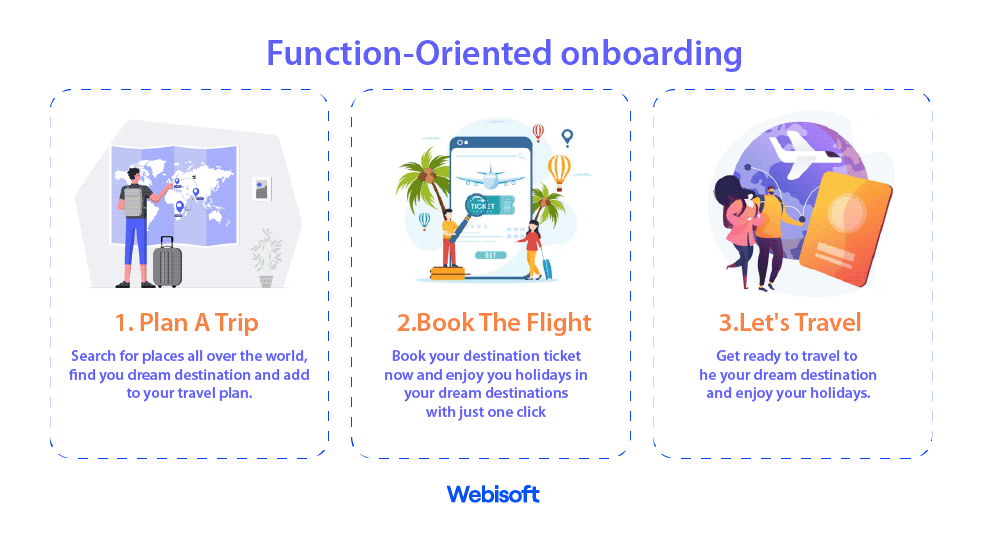
4. Gamified Onboarding: Gamified onboarding adds an element of fun and interactivity to the onboarding process. It incorporates game-like challenges, rewards, and achievements to engage users and motivate them to explore the app.
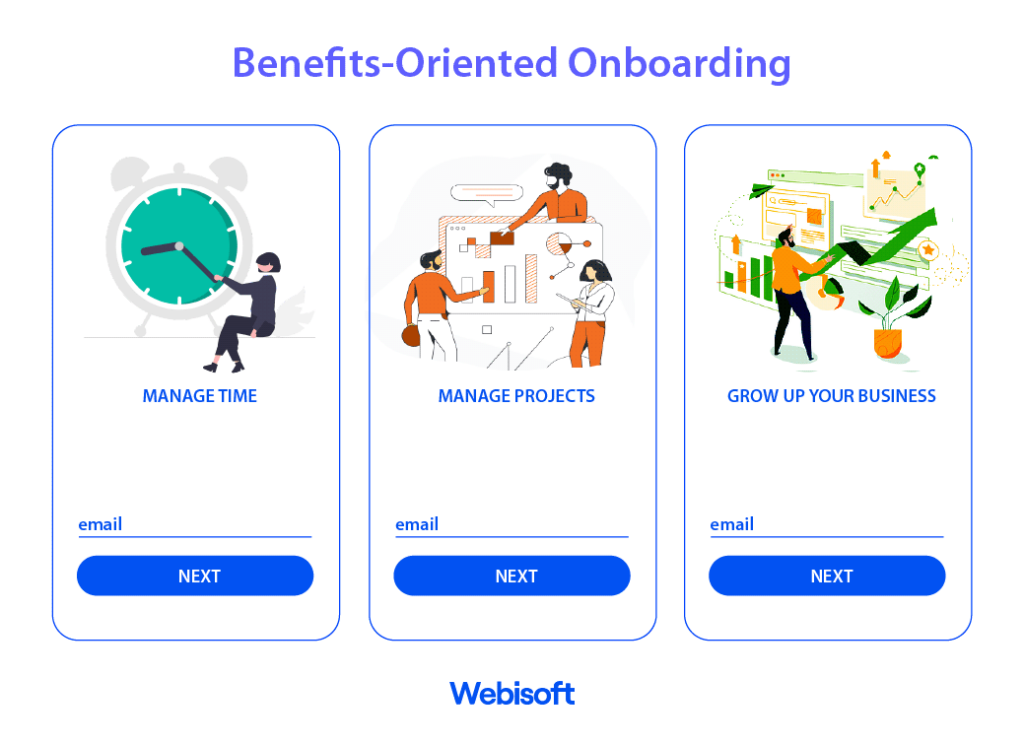
5. Empty State Screens: Empty state screens are displayed when there is no content or data available in the app. Instead of showing a blank screen, these screens provide helpful tips, suggestions, or instructions on what users can do or how to get started.
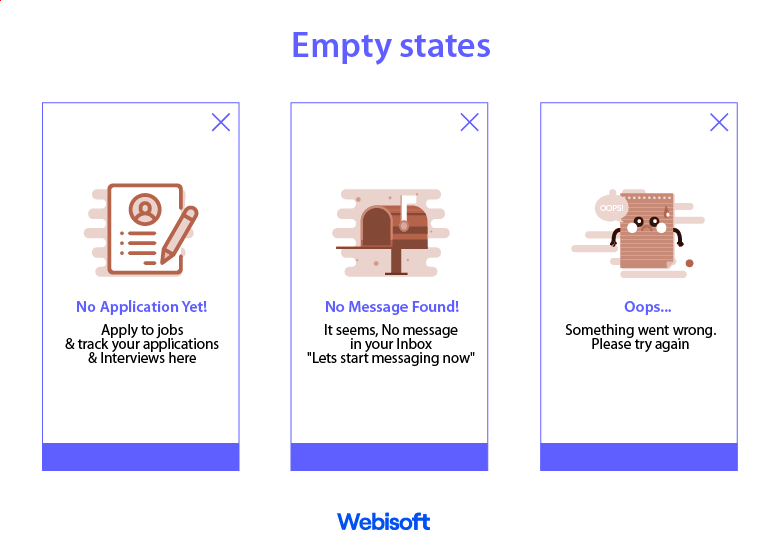
6. Personalized Onboarding: Personalized onboarding tailors the onboarding experience to each user’s specific needs and preferences. It may ask users to provide their interests or customize their app experience, delivering relevant content or recommendations based on their input.
7. Permission Requests: When an app requires access to certain device features or permissions, such as camera or location, permission requests onboarding explains why the app needs those permissions and how they will be used. It helps build trust and transparency with users.
Advantages of Using Mobile App Onboarding
Mobile app onboarding offers several advantages that make it valuable for both users and app developers. Let’s explore these advantages:
- Easy Learning: Onboarding helps users quickly understand how to use the app. It provides clear instructions, tutorials, and interactive guides that make it easier for users to navigate through the app’s features. This saves time and reduces frustration, allowing users to start using the app with confidence.
- Enhanced User Experience: App onboarding creates a positive and seamless user experience. It introduces users to the app’s unique features, showcases its value, and engages them from the very beginning. This improves user satisfaction, increases app usage, and encourages users to keep coming back.
- Increased App Adoption: Effective onboarding encourages users to fully adopt the app’s functionality. By demonstrating its benefits and highlighting key features, onboarding motivates users to explore and utilize all that the app has to offer. This leads to higher user engagement and a greater likelihood of users continuing to use the app over time.
- Reduced User Abandonment: Well-designed onboarding reduces the chances of users abandoning the app shortly after downloading it. By providing a clear and guided introduction, users are less likely to feel overwhelmed or confused, increasing their chances of staying engaged and becoming long-term users.
- Improved User Retention: Onboarding contributes to user retention by establishing a strong foundation of understanding and value. When users are effectively onboarded and see the benefits of the app, they are more likely to continue using it regularly. This boosts user loyalty and increases the chances of positive word-of-mouth recommendations.
21 Must-follow Mobile App Onboarding Practices
Onboarding practices play a crucial role in ensuring a smooth and user-friendly onboarding experience, helping users understand and appreciate the value of the app right from the start. By implementing these practices, you can increase user satisfaction, improve adoption rates, and set a solid foundation for long-term user engagement.
1. Clear and Concise Messaging
When introducing your app to users, it’s essential to use simple and straightforward language that clearly communicates its purpose and benefits. Avoid using technical jargon or complex terms that might confuse users. By keeping the messaging clear and concise, users can quickly grasp the main idea and understand how the app can improve their lives or solve a specific problem.
2. Visual Guidance
Visual cues play a vital role in guiding users through the app onboarding process. Arrows, animations, or highlighting specific areas can help direct users’ attention and show them how to navigate and interact with the app’s interface. Visual guidance is especially useful for demonstrating swipe gestures, tapping on buttons, or accessing different screens.
By incorporating visual elements, users can follow along visually, making it easier for them to understand and remember how to use the app.
3. Progressive Onboarding
Overwhelming users with too much information at once can be counterproductive. Instead, adopt a progressive onboarding approach, where you introduce features gradually. Start with the basics and provide simple instructions or tips to help users get started. As users become more comfortable with the app, you can gradually introduce more advanced features or additional functionalities.
This approach allows users to learn at their own pace, reducing any feelings of overwhelm and ensuring a smoother onboarding experience.
4. Interactive Tutorials
Engaging users through interactive tutorials can be highly effective in helping them understand how to use the app’s features. Instead of simply presenting information, interactive tutorials allow users to practice using the app in a hands-on manner. For example, you can provide a step-by-step walkthrough of a specific task and let users follow along by performing the actions themselves.
This interactive approach not only helps users learn by doing but also enhances their understanding and retention of the app’s functionality.
5. Personalized Recommendations
Tailoring the onboarding experience to individual users by app designers can significantly enhance their app experience. By gathering information about their preferences or interests during onboarding, you can provide personalized recommendations or suggestions. For example, if it’s a music streaming app, you can ask users about their favorite genres and artists to curate personalized playlists or recommendations.
This level of personalization makes users feel valued and increases their engagement with the app, as they see content that aligns with their interests right from the start.
6. Gamified Elements
Adding gamified elements to the onboarding practices can make them more enjoyable and motivate users to explore further. By incorporating game-like challenges, rewards, or achievements, you can create a sense of fun and accomplishment. For instance, you can award badges or points for completing specific onboarding tasks or encourage users to unlock levels as they progress.
Gamification not only makes the onboarding experience more engaging but also creates a sense of progression and encourages users to continue using the app.
7. Onboarding Videos
Sometimes, visuals speak louder than words. Using short onboarding videos can be an effective way to demonstrate how to use key features or perform specific tasks within the app. Videos provide a visual walkthrough that users can follow along, making it easier for them to understand complex or multi-step processes. By visually showcasing the app’s features and functionality, onboarding videos simplify the learning process and help users get up to speed quickly.
8. Onboarding Checklists
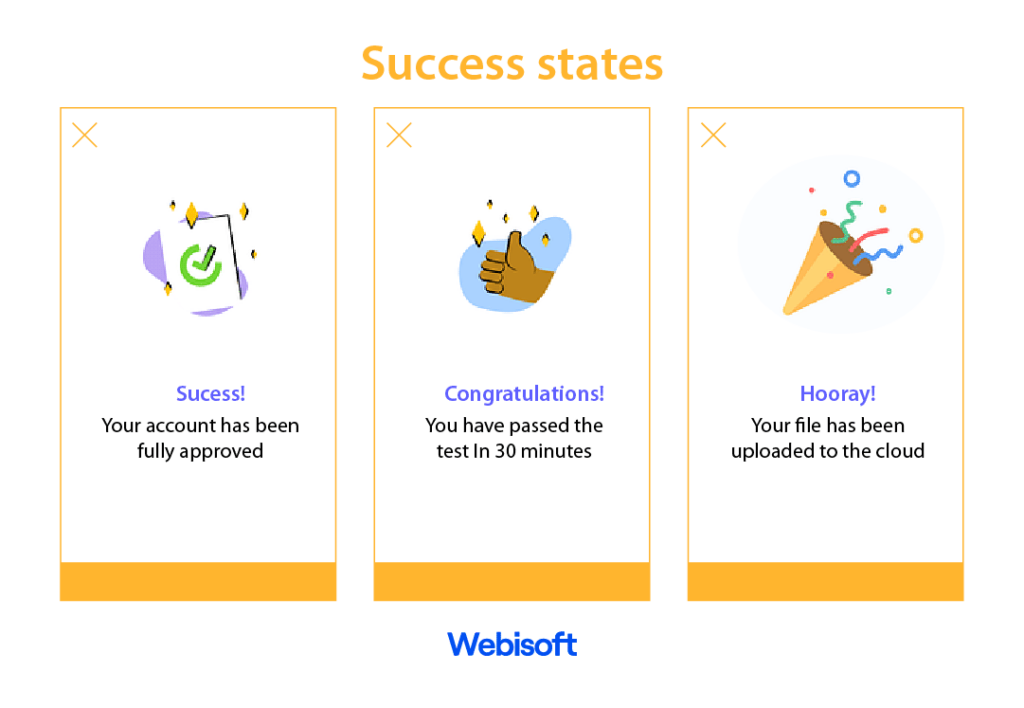
Breaking down the onboarding process into easy-to-follow checklists can help users track their progress and understand what steps they need to complete. A checklist can provide a clear roadmap, showing users their onboarding journey and what tasks are remaining. By ticking off completed items, users get a sense of accomplishment and can see their progress, motivating them to continue and complete the onboarding process.
9. User Onboarding Surveys
Collecting user feedback through surveys during the onboarding process can provide valuable insights into users’ needs and preferences. Surveys can be used to understand users’ expectations, gather demographic information, or gauge their satisfaction with the onboarding experience. By incorporating user feedback, you can make informed decisions about improving the onboarding process and tailor it to better meet users’ needs.
10. Onboarding Notifications
Timely push notifications can be leveraged during the onboarding process to guide and engage users. Notifications can be used to provide helpful tips, remind users to complete certain steps, or notify them of new features or updates. By keeping users engaged and informed, onboarding notifications serve as gentle reminders and support users as they navigate through the onboarding journey.
11. Social Sign-In
Offering users the option to sign in to your app using their existing social media accounts, such as Facebook or Google. This simplifies the registration process, as users can avoid creating new usernames and passwords. Social sign-in can also provide access to users’ social connections, enabling social features within the app.
12. Contextual Help
Providing contextual help or tooltips within the app interface assists users in understanding specific features or actions. These on-screen prompts offer relevant guidance at the right moment, ensuring users can easily navigate through the app and perform tasks without confusion.
13. Onboarding Progress Indicators
Showing users their progress in the onboarding model, such as through a progress bar or a series of completed steps can help the users tremendously. Progress indicators provide a sense of accomplishment and motivate users to continue with the onboarding journey.
14. Offline Onboarding
Ensuring that users can access necessary onboarding information even when they are offline also assisting the users. This allows them to learn about the app’s features and functionality at their convenience, regardless of their internet connectivity.
15. Minimal Input Fields
Minimizing the number of required input fields during onboarding reduces friction and makes the process quicker for the users. Only asking for essential information that is necessary for the app’s functionality, keeps the registration or onboarding forms concise and user-friendly.
16. App Permissions Explanation
Clearly explaining why the app requires specific permissions, such as access to the camera or location services also makes the onboarding process much more smooth. Informing users about how these permissions will be used and assuring them of their data privacy and security helps to create trust along with transparency.
17. Onboarding A/B Testing
Conducting A/B testing to compare different onboarding approaches and determining which ones work best for your target audience is also a good onboarding practice. Testing variations of onboarding workflows, visuals, or messaging to identify the most effective strategies helps to optimize the onboarding experience.
18. Onboarding Analytics
Utilizing analytics tools to gather data on user behavior during the onboarding process is also a good practice. Analyzing user interactions, drop-off points, and completion rates helps to gain insights into the effectiveness of the onboarding process. This data-driven approach helps identify areas for improvement and refine the onboarding experience.
19. Onboarding Feedback Channels
Providing channels for users to provide feedback directly within the app is another excellent onboarding practice. Including options for users to share their thoughts, report issues, or suggest improvements allows you to gather valuable insights and make adjustments to enhance the onboarding process.
20. Onboarding Localization
Adapting the onboarding content to different languages and cultures ensures a seamless experience for a global user base. Translating onboarding materials, including text, images, and videos, to cater to diverse audiences makes them feel comfortable and engaged from the start.
21. Continuous Improvement
Regularly analyzing user feedback and metrics to iterate and improve the onboarding process over time is also a must. Keeping up with user expectations, industry trends, and evolving user needs is extremely important even if it doesn’t seem so after a while. By consistently evaluating and enhancing the onboarding experience, you can ensure that it remains effective and impactful.
5 Real-life Instances of Correct Mobile App Onboarding
Life is the greatest teacher and learning is always incomplete without a few real-life examples. So, here are five real-life instances of correct mobile app onboarding explained:
When you first download the Instagram app, it guides you through a quick onboarding process. It asks you to sign up or log in with your Facebook account, making the registration process seamless. Then, it prompts you to follow some suggested accounts, helping you build your initial network and discover content you might be interested in.
Instagram’s onboarding ensures that you understand how to navigate the app and start engaging with its features right away.
Duolingo
Duolingo, a language learning app, provides an excellent example of onboarding. It introduces users to its interactive lessons through a step-by-step tutorial. Users are guided to select the language they want to learn and then taken through interactive exercises to practice vocabulary and sentence structure.
Duolingo’s onboarding gradually introduces new concepts, making language learning approachable and engaging.
Uber
Uber’s onboarding process is focused on simplicity and ease of use. Once you open the app, it prompts you to enter your pickup and drop-off locations. It then provides you with an estimated fare and shows available drivers in your area.
Uber’s onboarding makes it easy for users to understand how to request a ride, track their driver, and complete the payment process, ensuring a smooth and efficient user experience.
Spotify
When you first open the Spotify app, it offers a personalized onboarding experience. It asks about your music preferences and then creates custom playlists based on your choices. Spotify also provides a tutorial on how to navigate its features, such as searching for music, creating playlists, and discovering new artists.
Spotify’s onboarding tailors the app experience to each user’s musical tastes, making it engaging and enjoyable.
Airbnb
Airbnb’s onboarding process is focused on building trust and providing a personalized experience. The app prompts users to create a profile and verify their identity. It also encourages users to provide information about their travel preferences, allowing Airbnb to recommend suitable accommodations.
The onboarding process showcases the app’s safety measures and provides users with tips for using the platform effectively. Airbnb’s onboarding creates a sense of security and tailors the app experience to each user’s travel needs.
Frequently Asked Questions
What are the best apps for onboarding practices?
The best apps for onboarding practices prioritize seamless onboarding, clear instructions, and intuitive interfaces to guide users effectively. Examples include Slack, which offers a simple and interactive tutorial for team collaboration, and Trello, known for its visually appealing and informative onboarding process for project management.
What are the goals of app onboarding?
The goals of app onboarding are to help users understand how to use the app, experience its value, and feel comfortable and confident while using it. The primary objectives include introducing key features, guiding users through the app’s functionality, and ensuring a positive first impression. By achieving these goals, app onboarding increases user engagement, encourages long-term usage, and enhances overall user satisfaction.
What makes a great app experience?
Several key elements are crucial for a great app experience, including effective app onboarding. Here are some factors that contribute to a great app experience:
1. Intuitive User Interface: Clear icons and menus for easy navigation.
2. Seamless Onboarding: Smoothly guides users through app features.
3. Smooth Performance: Lag-free and crash-free app experience.
4. Personalization: Tailored content and recommendations to user preferences.
5. Clear and Concise Content: Presents information in a concise and understandable manner.
6. Seamless Integration: Smoothly integrates with other services or platforms.
7. Regular Updates and Bug Fixes: Keeps the app up-to-date and user-friendly.
8. Strong Customer Support: Gives reliable assistance and support to users.
Final Thoughts
The top 21 mobile app onboarding practices outlined in this article provide a comprehensive guide for app developers and designers to create a seamless and engaging onboarding experience. By implementing these practices, you can ensure that users understand the value and functionality of your app, leading to higher adoption rates and increased user satisfaction. From clear and concise messaging to personalized recommendations and gamified elements, each practice serves a specific purpose in enhancing the onboarding process.
As technology continues to evolve, it is crucial to stay up to date with the latest trends and user expectations. Regularly analyze user feedback, conduct A/B testing, and utilize analytics tools to continuously improve your onboarding process.
Remember to tailor the onboarding experience to different languages and cultures to cater to a global user base effectively. By prioritizing user-centric onboarding practices, you can ensure that your app stands out in the competitive mobile app market and provides a delightful experience for users in 2024 and beyond.
